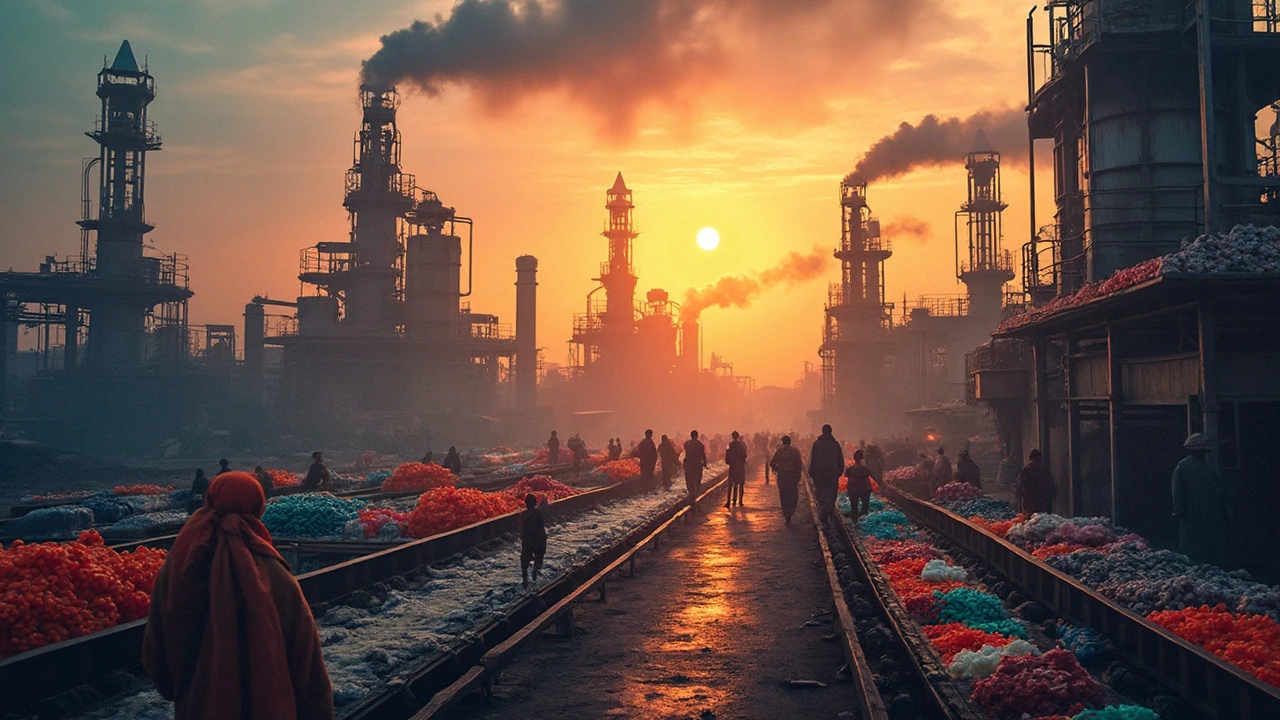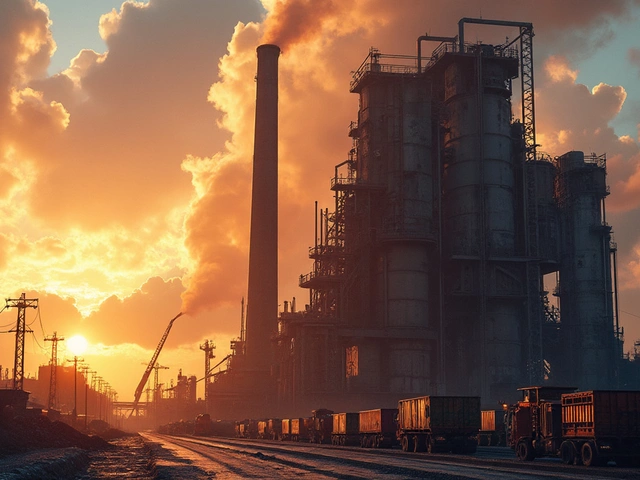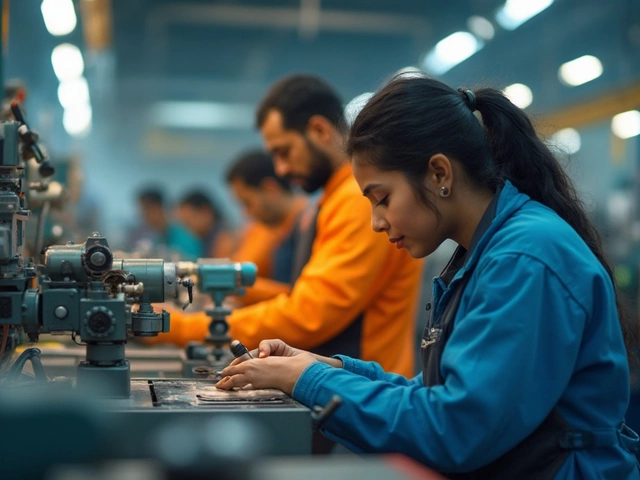Plastic is everywhere. Seriously, look around, and you’ll spot something made of plastic within seconds. It's no wonder that the industry behind this versatile material is massive and booming. But who sits at the top of this plastic throne? Let’s dig into the world's largest producer of plastics and see how they’ve managed to dominate the playing field.
You might think of big names like Dow or ExxonMobil when talking about plastics. After all, they've been synonymous with the industry for decades. However, the true champion is a bit of a surprise to some. It’s Sinopec, a giant based in China. Known for its extensive operations, this company's sheer scale and reach are jaw-dropping.
Why is Sinopec leading the pack? Well, they've got the resources and the market demand on their side. China's booming economy plays a huge role as domestic demand is off the charts. Add to that their strategic location and access to raw materials, and you can see why they're unbeatable right now.
- Introduction to Global Plastic Production
- Top Player in Plastic Manufacturing
- Key Factors for Success
- Impact on Global Markets
- Future of Plastic Production
Introduction to Global Plastic Production
Ever stop and think about just how big the plastic production industry really is? We're talking billions of tons every year, and it just keeps growing. The plastic market is essential to pretty much everything we use today, from packaging and household items to high-tech gadgets and infrastructure.
Globally, production hit approximately 390 million tons in 2021, showcasing how much we rely on this material. Asia is the top player, contributing over half of the world's plastic production, thanks to huge players like China and Japan.
Key Players in the Market
While Asia leads the way, you can't forget about regions like North America and Europe. They're both home to some major plastic manufacturing companies. Industry giants such as BASF, Dow, and LyondellBasell still hold substantial market shares.
Each region has its own strengths. For instance, North America is known for its innovation and sustainable practices, while Europe focuses heavily on recycling and reducing environmental impact.
Demand Drivers
The reasons for this huge demand? They're pretty straightforward. The versatility, durability, and affordability of plastic make it an easy choice for manufacturers. Not to mention, industries like automotive and electronics depend heavily on plastic components.
Challenges and Opportunities
It's not all smooth sailing, though. The industry faces challenges, especially with environmental concerns taking center stage. The push towards recycling and sustainable alternatives is stronger than ever, leading to opportunities for innovation.
| Region | Production (Million Tons) |
|---|---|
| Asia | 190 |
| North America | 69 |
| Europe | 55 |
Be it big corporations stepping up their sustainable game or startups coming in with fresh ideas, the future of the global plastic market is full of potential. As long as we have the demand, the industry will keep evolving.
Top Player in Plastic Manufacturing
If we had to crown one company as the king of plastic production, Sinopec stands out without a doubt. Based in China, this powerhouse is not just dominating but essentially reshaping the landscape of plastic manufacturing globally.
Why Sinopec? First off, they've built a vast network of production facilities that span not just China, but also reach various corners of the earth. They've mastered the art of scale. Size really does matter when it comes to producing plastic products efficiently. Places like Shanghai and Ningbo boast some of the largest petrochemical plants with outputs that dwarf many competitors around the world.
Strategic Advantages
You might be wondering, what gives Sinopec its edge? Well, having almost unparalleled access to raw materials is key. Think about the vast reserves of crude oil and natural gas they can tap into. That makes it easier to avoid supply chain hiccups that might slow others down.
Plus, there's the demand factor. China itself is a behemoth consumer of plastic, whether it's packaging, consumer goods, or industrial materials. Sinopec enjoys a home advantage, being right at the center of one of the largest markets in the world.
Innovations and Sustainability
Interestingly, Sinopec isn't just resting on its laurels. They've committed to making their processes more environmentally friendly. Investing heavily in sustainability, they focus on reducing carbon emissions and developing recyclable and biodegradable plastic options. This is not only good for the planet but also helps them stay ahead in an industry that's often criticized for its environmental impact.
Check this out - they've set a goal to recycle 10 million tons of plastic annually by 2030. It's a big move, signaling their awareness of global ecological concerns. Pretty forward-thinking, right?
| Year | Production (Million Tons) |
|---|---|
| 2022 | 90 |
| 2023 | 95 |
| 2024 | 100 |
These stats illustrate just how massive Sinppec's operation is and how it continuously ramps up its capacity. As the company's production grows, so do its responsibilities and possibilities within global markets.
All in all, as we keep an eye on industry trends, Sinopec's strategies and execution set a benchmark for others in the plastic manufacturing game. They're a giant, not just in size, but in innovation and market influence. Watching how they pivot and evolve will be crucial for anyone interested in the future of plastics.

Key Factors for Success
Wondering why plastic production giants like Sinopec sit at the top? It’s not just luck. Several key factors contribute to their massive success.
1. Strategic Access to Resources
Any large-scale plastic manufacturing operation needs a reliable supply of raw materials. The big players have this covered thanks to their extensive networks and strategic partnerships, often having direct access to critical resources like crude oil and natural gas. This access ensures they can produce large quantities at lower costs.
2. Cutting-Edge Technology
Innovation isn’t just a buzzword here. These companies invest heavily in cutting-edge tech. From advanced polymer technology to highly efficient production methods, staying ahead in tech keeps costs down and quality up.
3. Scale of Operations
Size matters. The sheer scale at which these companies operate allows them to enjoy economies of scale. They can meet the immense demand without breaking a sweat, keeping them always ready to supply both local and global markets.
4. Market Demand
With sectors like construction, automotive, and packaging pushing the demand higher, these companies are strategically positioned in high-demand markets. In particular, the growth of industries in Asia has surged demand, benefiting local giants significantly.
5. Regulatory Navigation
Let’s face it—regulations can be a minefield. Successful companies hire top-notch legal teams to ensure they’re always on the right side of the law, allowing them to avoid costly penalties and disruptions.
6. Sustainability Efforts
People care about the planet, and so do the top players. While it may seem ironic, sustainability is a significant focus. Companies are working on biodegradable plastics and recycling initiatives to keep up with the global sustainability push. Global market awareness and eco-friendly practices are gaining traction, with some companies even setting ambitious zero-waste goals.
In summary, dominating the global market of plastic production isn’t for the faint-hearted. It takes a well-oiled machine with strategic planning, smart investments, and a finger on the pulse of market needs and regulations.
| Factor | Impact |
|---|---|
| Resource Access | Lower costs, stable supply |
| Technology | Higher efficiency, better quality |
| Scale of Operations | Economies of scale |
| Market Demand | Constant growth opportunities |
| Regulatory Navigation | Reduced legal risks |
| Sustainability | Positive public perception |
Impact on Global Markets
The influence of major plastic production companies on global markets can't be overstated. Take Sinopec, for example. This company's reach extends far beyond China, and its massive capacity influences pricing and supply worldwide.
When a company like Sinopec churns out plastic products, it affects everything from car manufacturing to packaging industries across the globe. These companies are pivotal in setting trends and dictating the direction of the global market. When they make a move, others sit up and take notice.
Pricing Dynamics
Because of their size and efficiency, Sinopec and others often have the power to influence global pricing. How? By producing in such large quantities, they can afford to sell at lower prices. This often pressures smaller companies to follow suit or risk losing market share. Such price dynamics can lead to lower costs for end products but also challenges for smaller manufacturers.
Supply Chain Stability
Another biggie is supply chain stability. These giant producers ensure a steady flow of materials, which keeps industries moving smoothly. Without them, sudden shortages could send ripples across industries, creating delays and driving up costs. It's their stable output that helps keep everything ticking like clockwork.
Environmental Concerns
But it's not all rosy. The environmental impact of these plastic manufacturers is massive. There's a growing push for sustainability and reducing plastic waste, and the industry's biggest players are under pressure to adapt. Efforts like transitioning to biodegradable options or improving recycling rates are becoming industry standards, pushed hard by these market leaders.
Curious about how much plastic is produced annually?
| Year | Global Plastic Production (Million Tonnes) |
|---|---|
| 2022 | 390 |
| 2023 | 413 |
| 2024 | 432 |

Future of Plastic Production
The world of plastic production is on the brink of a remarkable evolution. With mounting environmental concerns and the rise of eco-friendly consciousness, companies are under pressure to find sustainable solutions. This doesn't mean plastic is going away anytime soon, but its future is certainly leaning towards innovation and responsible production.
Bioplastics: The Green Revolution
One significant direction is the move towards bioplastics. These are materials derived from renewable sources like corn starch, sugarcane, and even algae. They're designed to break down more easily than traditional plastics. As the technology to produce these materials becomes more efficient, we expect to see them take a bigger slice of the global market pie.
Recycling Innovations
Recycling is another area witnessing a leap forward. Companies are investing in advanced technologies to recycle plastics more effectively and at a lower cost. Chemical recycling, for instance, can convert plastic waste back into its original monomers, making it possible to create new materials as if they were virgin. This closed-loop system is a hot topic in sustainability discussions.
Impact of Regulation
Government regulations are also shaping the future. In many parts of the world, laws are getting stricter about plastic use, particularly single-use plastics. This regulatory push is forcing manufacturers to adapt quickly, and those who can evolve may find themselves ahead of the competition.
| Year | Global Plastic Production (Million Tons) | Bioplastics Share |
|---|---|---|
| 2025 | 400 | 5% |
| 2030 | 450 | 10% |
| 2040 | 500 | 20% |
As we look ahead, it’s clear that the industry is poised for change. The companies that will thrive are those that embrace these transformations while still meeting the high demands of the plastic production market. Exciting times lie ahead!






